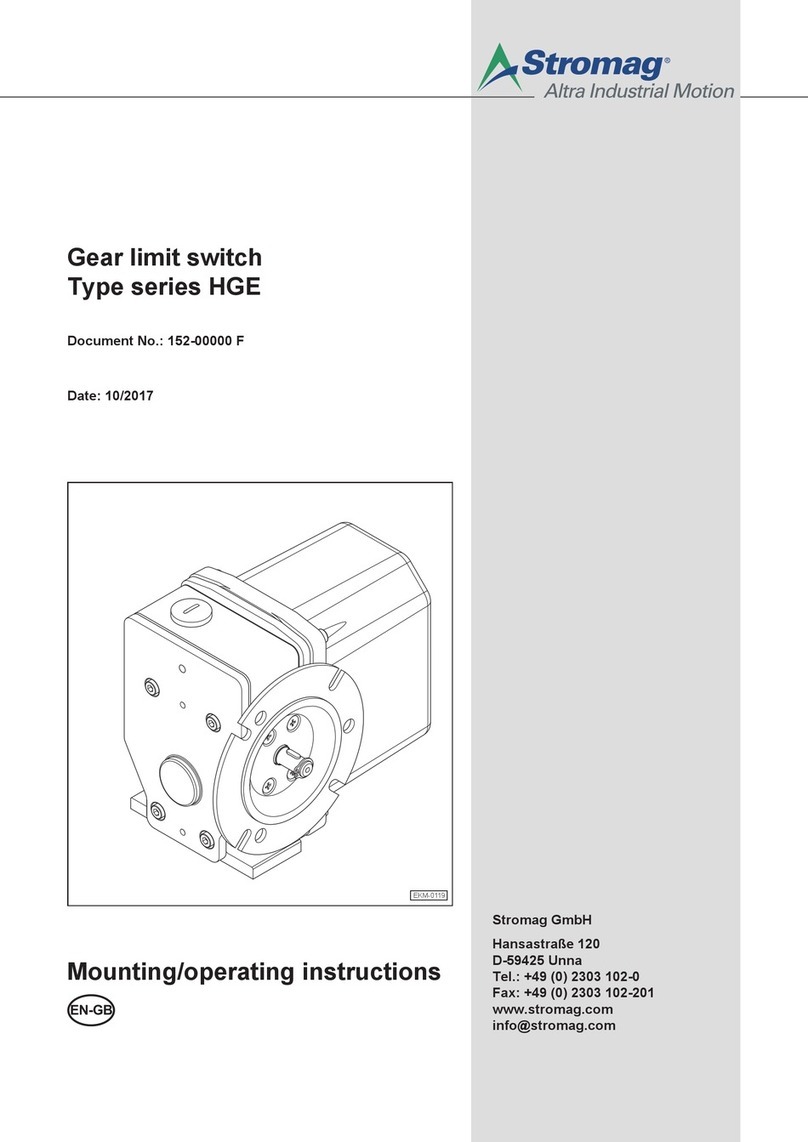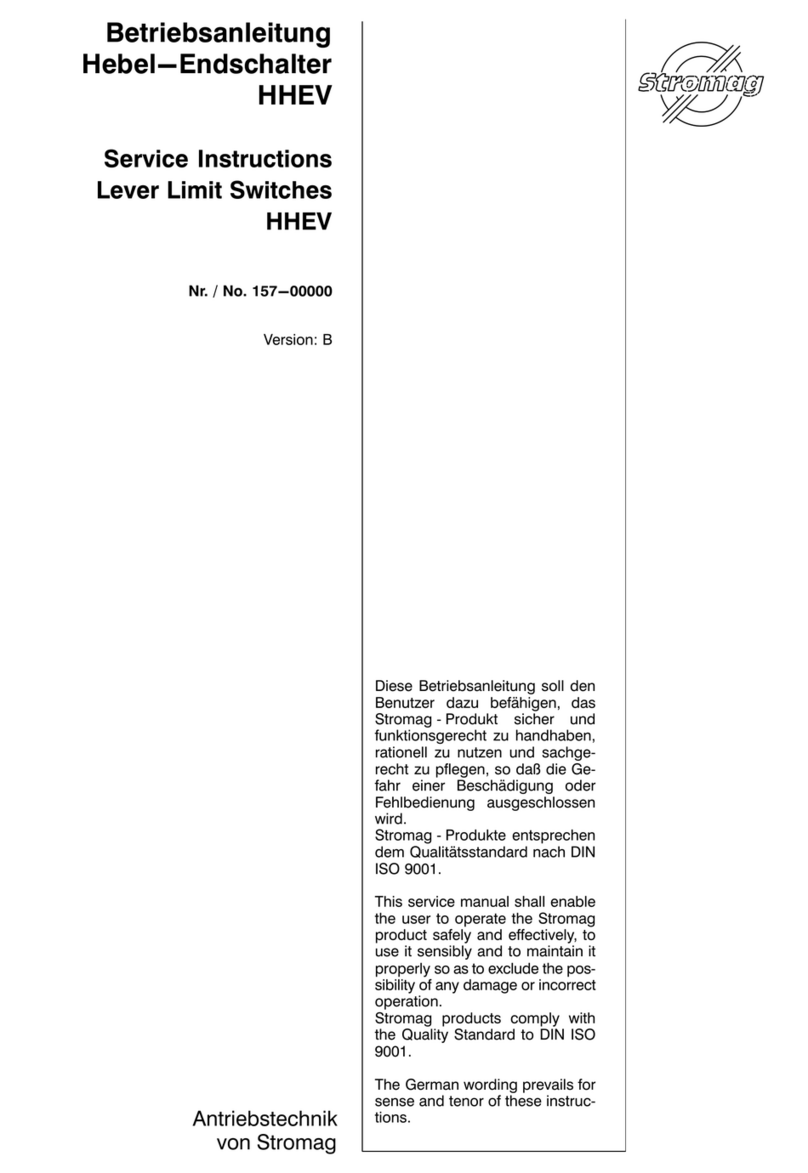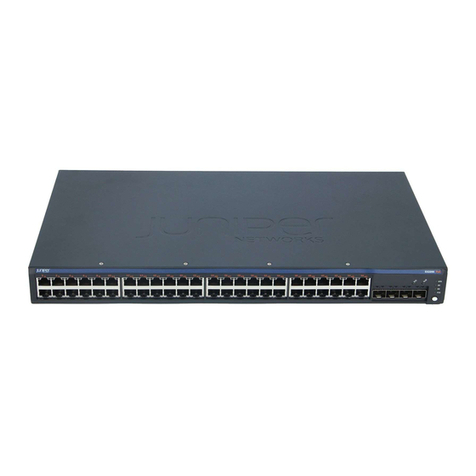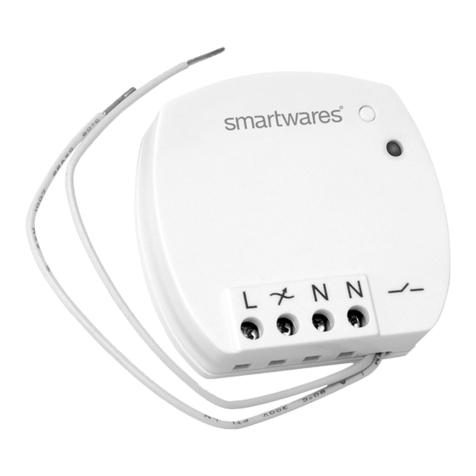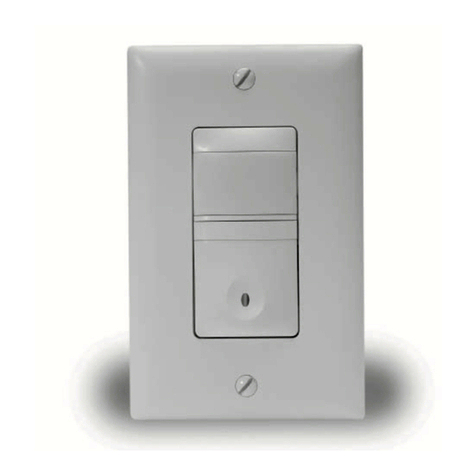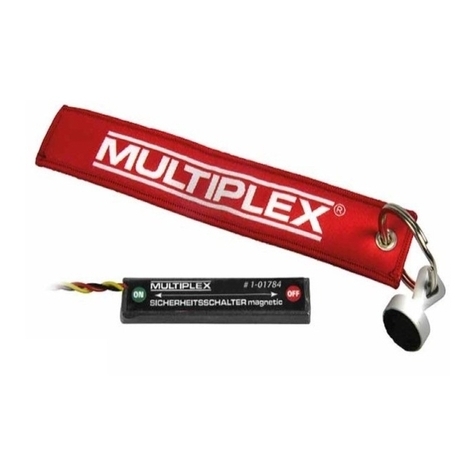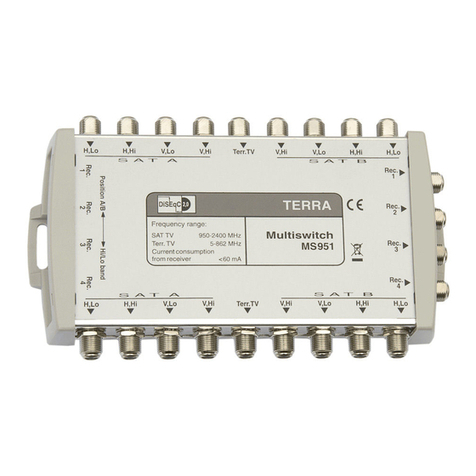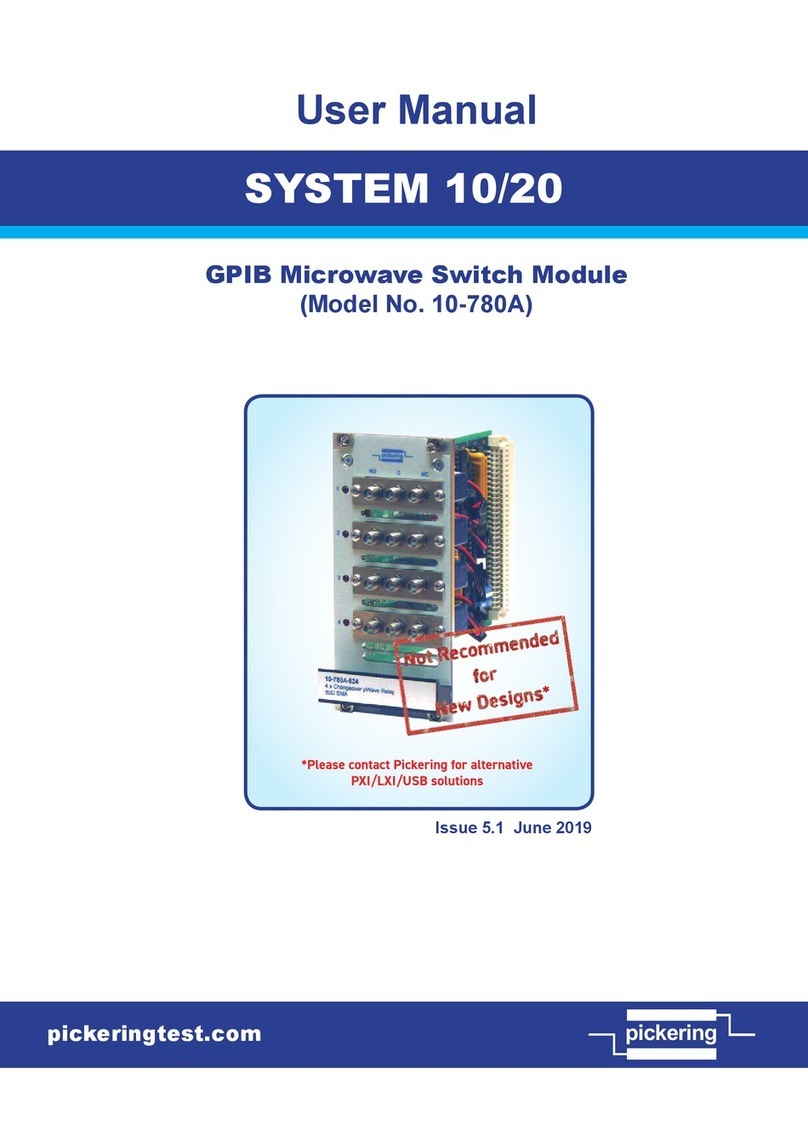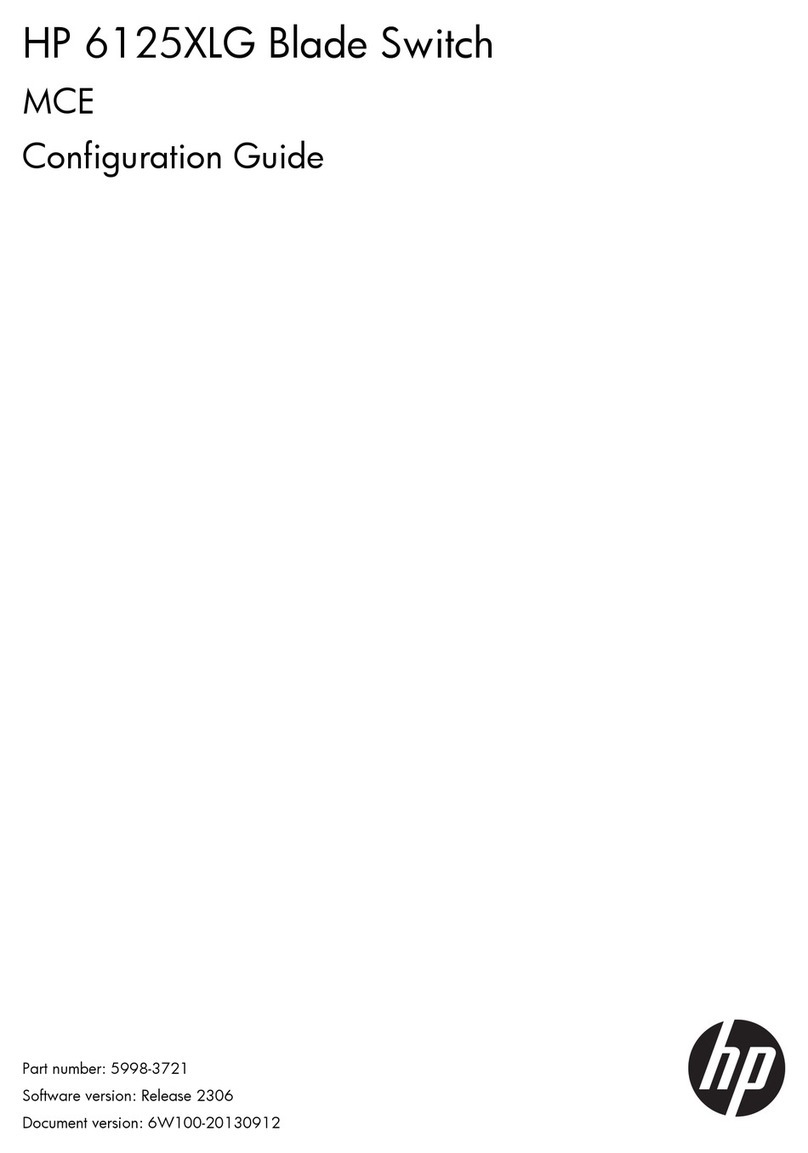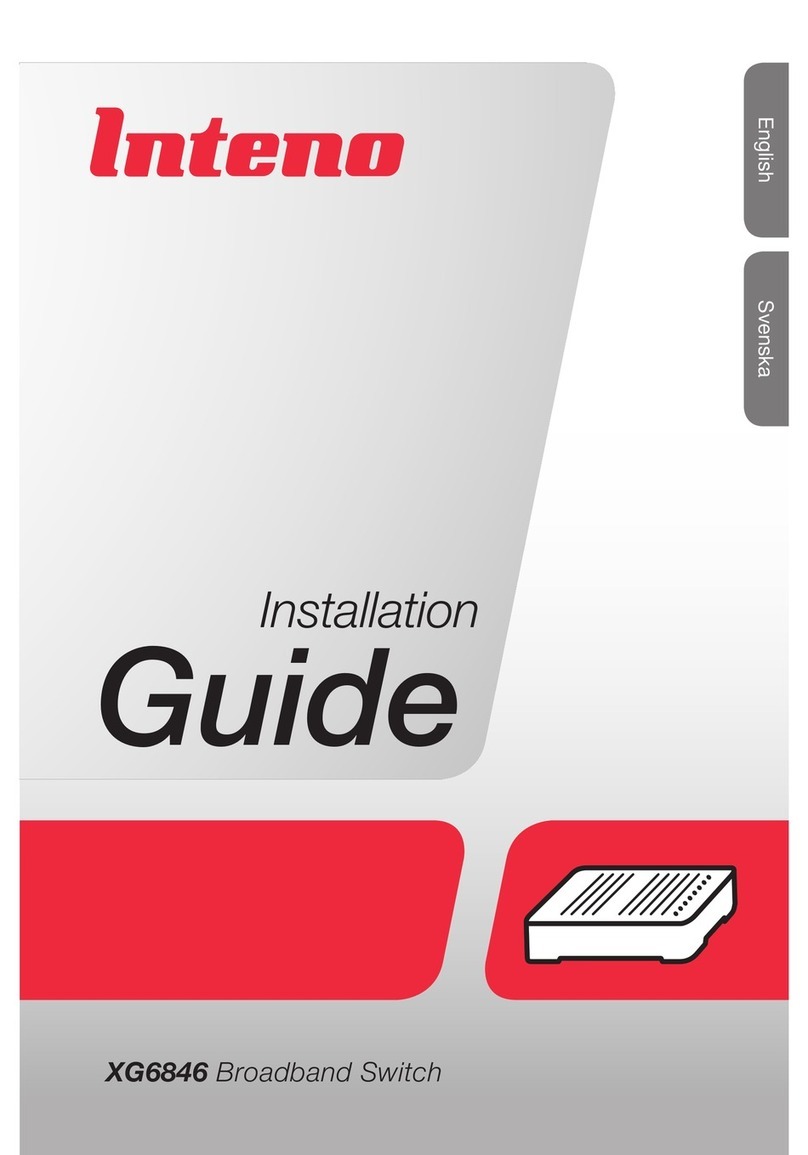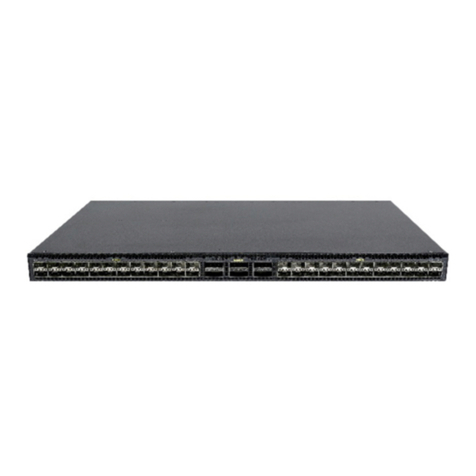Stromag 51 Series User manual

Geared Cam Limit Switch
Series 51
Document No.: 151-00004 H
Date: 01 / 2018
Translation of the Original
assembly / operating
instructions
Stromag GmbH
Hansastraße 120
D-59425 Unna
Tel.: +49 (0) 2303 102-0
Fax: +49 (0) 2303 102-201
www.stromag.com

Original assembly/operating instructions Gear limit switch Type series 51 • No. 151-00004 H • 01.2018 2
Content
1Introduction ..................................................................................................................................... 5
1.1 About this documentation ...................................................................................................................... 5
1.1.1 Target group....................................................................................................................................... 5
1.1.2 Use/storage........................................................................................................................................ 5
1.2 Using the documentation correctly......................................................................................................... 6
1.2.1 Text formats....................................................................................................................................... 6
1.2.2 Definition of terms.............................................................................................................................. 6
1.3 Warranty and liability ............................................................................................................................. 7
1.3.1 Guarantee.......................................................................................................................................... 7
1.3.2 Copyright............................................................................................................................................ 7
2For your safety................................................................................................................................ 7
2.1 Safety concept of the documentation..................................................................................................... 7
2.2 Required personnel qualifications.......................................................................................................... 8
2.3 Intended use.......................................................................................................................................... 8
2.3.1 Application limits ................................................................................................................................ 8
2.3.2 Approvals........................................................................................................................................... 8
2.4 Foreseeable misuse .............................................................................................................................. 8
2.5 Non-intended use .................................................................................................................................. 8
2.6 EC Declaration of Conformity................................................................................................................ 9
2.6.1 Standards applied.............................................................................................................................. 9
2.7 Possible residual risks........................................................................................................................... 9
2.7.1 Mechanical dangers........................................................................................................................... 9
2.7.2 Thermal dangers................................................................................................................................ 9
2.7.3 Electrical danger ................................................................................................................................ 9
2.8 Safety symbols/pictograms in the documentation.................................................................................. 9
2.8.1 Warning symbols................................................................................................................................ 9
2.8.2 Hazard classifications ...................................................................................................................... 10
2.8.3 Mandatory symbols.......................................................................................................................... 10
2.8.4 Note ................................................................................................................................................. 10
2.8.5 Enviromental Protection / Recycling................................................................................................. 10
2.9 GCLS safety devices........................................................................................................................... 11
2.10 Safety symbols/pictograms on the GCLS ............................................................................................ 11
2.11 Wear personal protective equipment................................................................................................... 11
2.12 Basic responsibilities of the operator and personnel............................................................................ 11
2.13 Safe handling of rotating components ................................................................................................. 11
2.14 Safe handling with hot surfaces........................................................................................................... 11
2.15 Safe handling with electrical hazards................................................................................................... 12
2.15.1 Responsibility of the operator........................................................................................................... 12
2.15.2 Applying the five safety rules ........................................................................................................... 12
2.15.3 IP protection classes........................................................................................................................ 12
2.15.4 Electromagnetic compatibility........................................................................................................... 12
2.16 Environmental protection..................................................................................................................... 12
3Transport and storage.................................................................................................................. 13
3.1 Transport............................................................................................................................................. 13
3.1.1 Unpacking........................................................................................................................................ 13
3.2 Scope of delivery................................................................................................................................. 13
3.2.1 Pre-mounting condition.................................................................................................................... 13
3.3 Storage................................................................................................................................................ 14
4Technical specifications .............................................................................................................. 14
4.1 Product data........................................................................................................................................ 14
4.1.1 Dimensions ...................................................................................................................................... 14
4.1.2 Gear data, type series 51................................................................................................................. 15
4.1.3 Gear data, type series 51 DZ........................................................................................................... 16
4.1.4 General information, GCLS type series 51....................................................................................... 17
4.1.5 Specific electrical values and position of the contact ....................................................................... 17
4.1.6 Contact positions.............................................................................................................................. 18
4.1.7 Permissible radial force.................................................................................................................... 19
4.1.8 Type code ........................................................................................................................................ 20
4.1.9 Unit................................................................................................................................................... 21
4.2 Dimensional Drawing........................................................................................................................... 21
4.3 Marking on the product........................................................................................................................ 21
5Structure and function ................................................................................................................. 22

Original assembly/operating instructions Gear limit switch Type series 51 • No. 151-00004 H • 01.2018 3
5.1 Component designations..................................................................................................................... 22
5.2 Design, task and function of the assembly groups .............................................................................. 22
5.2.1 Electrical connection versions.......................................................................................................... 22
5.2.2 Mounting position............................................................................................................................. 22
5.2.3 Drive................................................................................................................................................. 23
5.3 Optional equipment available .............................................................................................................. 23
5.3.1 Drive Flange..................................................................................................................................... 23
5.3.2 Block adjustment.............................................................................................................................. 24
5.3.3 Special cam discs ............................................................................................................................ 25
5.3.4 Design with position feedback system ............................................................................................ 26
5.3.5 Ausführung mit Heizwiderstand........................................................................................................ 28
6Assembly ....................................................................................................................................... 29
6.1 Special safety guidelines ..................................................................................................................... 29
6.2 Conditions for assembly and fixing...................................................................................................... 29
6.2.1 Special tools..................................................................................................................................... 29
6.2.2 Assembly precision.......................................................................................................................... 29
6.2.3 Tightening torques ........................................................................................................................... 29
6.3 Assembly mechanics........................................................................................................................... 30
6.3.1 Assembly design IP20 (without housing) ......................................................................................... 30
6.3.2 Housing assembly, IP65 .................................................................................................................. 31
6.3.3 Housing assembly, IP66 .................................................................................................................. 31
6.3.4 Assembly of the flange design, B55................................................................................................. 32
6.3.5 Assembly of the mounting bracket, B3............................................................................................. 32
6.4 Electrical assembly.............................................................................................................................. 32
6.4.1 Insert the connection cable into the GCLS....................................................................................... 33
6.4.2 Connect the screw connections ....................................................................................................... 33
6.4.3 Connect the flat plug........................................................................................................................ 34
6.4.4 Connect the earth conductor for IP66 housings............................................................................... 34
6.4.5 Connect the earth conductor for IP65 housings............................................................................... 34
6.5 Wiring diagram..................................................................................................................................... 35
6.5.1 Electrics ........................................................................................................................................... 35
6.6 Switching point adjustment.................................................................................................................. 35
6.6.1 Mode of function............................................................................................................................... 35
6.6.2 Adjusting the switching points.......................................................................................................... 36
6.7 Complete the housing.......................................................................................................................... 37
6.7.1 Mount the MH housing, IP65............................................................................................................ 37
6.7.2 CxZ, MxZ housing, mount 0 - 1 intermediate piece.......................................................................... 37
6.7.3 Mount the CxZ, MxZ housing from 2 intermediate pieces................................................................ 38
6.8 Correct disposal/recycling of operating and auxiliary materials. .......................................................... 38
7Operation ....................................................................................................................................... 38
7.1 Special safety guidelines..................................................................................................................... 38
7.2 Initial commissioning............................................................................................................................ 38
7.3 Handling .............................................................................................................................................. 38
7.3.1 Operating conditions........................................................................................................................ 38
7.4 Recommissioning ................................................................................................................................ 38
7.5 Decommissioning ................................................................................................................................ 38
7.5.1 Temporary decommissioning........................................................................................................... 38
7.5.2 Final decommissioning..................................................................................................................... 38
8Maintenance and inspections...................................................................................................... 39
8.1 Special safety guidelines ..................................................................................................................... 39
8.2 Measures for environmental protection................................................................................................ 39
8.3 General points ..................................................................................................................................... 39
8.4 Maintenance and inspection intervals.................................................................................................. 39
8.4.1 Cleaning........................................................................................................................................... 39
9Troubleshooting............................................................................................................................ 40
9.1 Operational issues and their solutions................................................................................................. 40
10 Disassembly............................................................................................................................... 40
10.1 Special safety guidelines..................................................................................................................... 40
10.2 Removing the GCLS............................................................................................................................ 40
10.3 Final decommissioning........................................................................................................................ 40
11 Ordering spare parts ................................................................................................................. 40
11.1 Data for ordering spare parts............................................................................................................... 40
11.2 Service address................................................................................................................................... 41

Original assembly/operating instructions Gear limit switch Type series 51 • No. 151-00004 H • 01.2018 5
1 Introduction
1.1 About this documentation
Stromag GmbH strongly emphasises that the technical details such as dimensions, weights in kg, tolerances,
tightening torques and units required for assembly, such as securing means and lubricants, must be obtained
from the dimensional drawing.
Should this information be necessary during assembly, a corresponding point in these mounting/operating
instructions will be referenced on the dimensional drawing.
A dimensional drawing is supplied as a separate document and can be requested additionally from our aftersales
services, see section 11.2. For this, the information on ordering spare parts is required, see section 11.1.
For the purpose of simplification, the following designations are used in the mounting/operating instructions.
•Mounting/operating instructions will be referred to as Documentation in the following.
•The gear limit switch, type series 51, will be referred to as GCLS in the following.
This documentation makes it easier for the operator to familiarise himself with the GCLS and to use it for its
intended application.
This documentation covers various GCLS designs. The figures used are partly by way of example only. The
specific design of the supplied GCLS is shown in the dimensional drawing, see section 4.2.
The documentation contains important instructions on how to operate the GCLS safely, properly and
economically. Observing the documentation helps to avoid dangers, to reduce repair costs and down times and to
increase the reliability as well as the operating life of the GCLS. Read the documentation carefully and thoroughly.
1.1.1 Target group
The documentation is limited to use by qualified as well as trained personnel.
The documentation must be read and applied by every person that is assigned with performing at least one of the
following tasks:
•transport
•assembly,
•use,
•maintenance and inspections,
•troubleshooting,
•disassembly
•disposal of operating and auxiliary materials
1.1.2 Use/storage
This documentation must always be kept to hand at the operation location of the GCLS. The documentation must
then be integrated into the overall documentation of the machine and into the safety concept. When selling the
GCLS, the documentation must also be passed on.

Original assembly/operating instructions Gear limit switch Type series 51 • No. 151-00004 H • 01.2018 6
1.2 Using the documentation correctly
1.2.1 Text formats
The following symbols/figures are used for special text positions in the documentation:
1.2.2 Definition of terms
Operator
The operator is the businessperson/company that operates the GCLS for its intended use or has it operated by
qualified as well as trained personnel.
Trained personnel
Trained personnel are those that can prove they have been instructed by Stromag GmbH or in accordance with
the technical documentation of Stromag GmbH. They are able to carry out the work assigned to them and avoid
known dangers.
User
The user is the person that has been trained by the operator and assigned with the use of the GCLS.
Qualified personnel
Qualified personnel are those that are able to carry out the work assigned to them and identify and avoid any
possible dangers as a result of their professional training, knowledge and experience, as well as knowledge of the
applicable standards and guidelines. Qualified personnel are employees of the operator or those that have been
authorised to carry out the work.
Qualified electrician
A qualified electrician is someone who is trained and has knowledge and experience of electrical equipment. As
such, qualified electricians must have knowledge of the applicable standards and guidelines, be able to assess
the work assigned to them and identify and avoid potential hazards.
Symbol Explanation
●Indicates bulleted lists
—Indicates subordinate bulleted lists
►Indicates handling instructions and information in the safetyguidelines
1. 2. 3. et seq. Indicates work steps
Fig. 1, 2, 3, et seq. Numbering of figures
A, B, C, et seq. Indicates areas in the figures
a, b, c, et seq. Indicates dimensions
Indicates position numbers in the figures
(1)/(2)/(3) Indicates position numbers in the text
1

Original assembly/operating instructions Gear limit switch Type series 51 • No. 151-00004 H • 01.2018 7
1.3 Warranty and liability
The "General delivery and business terms and conditions" of Stromag GmbH apply. Stromag GmbH shall not
recognise any warranty or liability claims for personal and material damage if they result from one or more of the
following causes:
•non-intended use of the GCLS (see also "Intended use"), see section 2.3
•non-observance of the information, instructions and interdictions in this documentation
•unauthorised constructional modifications to the GCLS
•insufficient monitoring of parts which are subject to wear and tear
•maintenance work performed improperly or too late
•catastrophic events caused by external influences or force majeure
1.3.1 Guarantee
The "General trade and delivery terms and conditions of delivery" of Stromag GmbH always apply.
1.3.2 Copyright
This documentation is a certified document as per the terms of the law against unfair competition.
The copyright is held by:
Stromag GmbH
Hansastraße 120
D-59425 Unna
Germany
This documentation is intended for the operator of the GCLS and his personnel. It contains text and drawings
which, without the express permission of the manufacturer, must not be
•reproduced,
•distributed or
•made available to others in any other way, either in full or in part.
Non-compliance will result in damages being sought.
2 For your safety
2.1 Safety concept of the documentation
In accordance with the risk assessment carried out, the safety concept in this documentation is structured in the
following way:
•The general safety guidelines for the operator and the user are listed in this section.
•Section-related safety guidelines are listed at the start of the respective section.
•Safety guidelines related to handling must be followed before each safety-related work step.

Original assembly/operating instructions Gear limit switch Type series 51 • No. 151-00004 H • 01.2018 8
2.2 Required personnel qualifications
The following table shows the qualifications specified for the different tasks.
•Only employ qualified or trained personnel.
•Do not authorise people whose ability to react is impaired, for example by the influence of drugs, alcohol,
medication or similar. Observe the specific national age guidelines.
•Observe all other nationally-applicable guidelines of the respective country of use.
2.3 Intended use
The GCLS is exclusively intended for use in industrial areas and must only be used to open electrical circuits
through the positive locking entrainment of a driven shaft. Geared cam limit switches of type series 51 (GCLS) are
universal, mechanical switchgear that show a maximum number of shaft revolutions to the angle of rotation of the
installed cam disc. Mechanical contacts are actuated by these cam discs.
The GCLS may only be operated with the correctly-installed and functioning IP protection classes.
2.3.1 Application limits
The application limits are defined in the technical specifications, see section 4.1. The GCLS must not be used in
potentially explosive areas.
2.3.2 Approvals
Overview of the respective national and international approvals of the GCLS, see section 4.1.8.
2.4 Foreseeable misuse
Engaging the contacts using elements other than the cam discs (e.g. screw drivers, wires, etc.) can cause
damage.
2.5 Non-intended use
Any use other than the intended use of the GCLS may lead to dangerous situations.
•Only use the GCLS for its intended use in accordance with the details in this documentation, especially in
observing the application limits given in the technical specifications.
•Reconstruction, retrofitting or modification of the construction or individual equipment parts, with the aim of
changing the application range or the usability of the GCLS, should be avoided.
•Do not use the GCLS as a climbing aid.
Claims for any damage resulting from non-intended use are exempted. The operator bears sole responsibility for
damage caused by non-intended use.
Task Personnel
Transport Trained personnel
Assembly Qualified personnel
Initial commissioning Qualified personnel
Operation Qualified personnel
Preventive maintenance Qualified personnel
Troubleshooting Qualified personnel
Decommissioning Qualified personnel
Disassembly, disposal Trained personnel

Original assembly/operating instructions Gear limit switch Type series 51 • No. 151-00004 H • 01.2018 9
2.6 EC Declaration of Conformity
The GCLS is supplied with an EC Declaration of Conformity, see section 12. The EC Declaration of Conformity
certifies that the GCLS complies with the essential health and safety requirements of the Machinery Directive in
terms of its design, including with the amendments applicable at the time of the declaration.
2.6.1 Standards applied
An overview of the applied harmonised standards can be found in the EC Declaration of Conformity supplied.
2.7 Possible residual risks
Residual risks are particular dangers that cannot be eliminated when using the GCLS, despite its safety-
orientated construction.
Residual risks are not obviously recognisable and could be the source of a possible injury or health risk.
Special reference is made to possible residual risks in the following:
2.7.1 Mechanical dangers
Danger due to rotating parts during:
•operation without separating protective equipment or safety shut-down
2.7.2 Thermal dangers
Danger resulting from contact with hot surfaces/components when:
•optional heating is installed
•work is carried out on the GCLS without personal protective equipment
2.7.3 Electrical danger
Danger due to contact with live components:
•when defect
•with an open housing cover
•caused by improper work on live components
2.8 Safety symbols/pictograms in the documentation
The following safety symbols/pictograms and indications of particularly important details are used in the
documentation.
2.8.1 Warning symbols
Required safety guidelines are indicated in the documentation through pictograms and in addition begin with
signal words that emphasise the extent of damage to be expected.
The safety guidelines are structured as follows:
SIGNAL WORD
Type and source of the hazard
Possible consequences of non-observance, as well as explanations of the source of the hazard.
Measures/handling instructions to be followed in order to avoid hazards or any damage.

Original assembly/operating instructions Gear limit switch Type series 51 • No. 151-00004 H • 01.2018 10
2.8.2 Hazard classifications
The safety symbol in conjunction with the signal word means:
DANGER
Indicates an immediate high risk danger, which can lead to death or serious physical injury if not
avoided.
CAUTION
Indicates a possible medium risk danger, which can lead to death or serious physical injury if not
avoided.
ATTENTION
Indicates a possible low risk danger, which can lead to slight or medium physical injury or material
damage if not avoided.
2.8.3 Mandatory symbols
Basic protection
As basic protection when working, always wear the listed personal protective equipment.
2.8.4 Note
NOTE
Indicates special user tips and other particularly useful or important information for efficient work as
well as economical use.
2.8.5 Enviromental Protection / Recycling
ENVIRONMENTAL HAZARD
Indicates environmental hazards as well as measures for environmental protection.
RECYCLING
Indicates measures for recycling or disposal of components as well as auxiliary and operating
materials.
Mandatory symbols Explanation
Wear protective clothing
Wear hand protection
Wear foot protection
Wear head protection

Original assembly/operating instructions Gear limit switch Type series 51 • No. 151-00004 H • 01.2018 11
2.9 GCLS safety devices
The GCLS does not have any safety devices of its own.
Except for: certain GCLSs with special housings, which are equipped with a protective cover in the gear wheel
area.
Rotating components of the GCLS that can cause hazards after assembly due to pulling in, must be secured by
the machine operator.
2.10 Safety symbols/pictograms on the GCLS
The GCLS is equipped with the following safety symbols/pictograms.
2.11 Wear personal protective equipment
Personal protective equipment must be worn for all work to be carried out, see section 2.8.3. The wearing of
personal protective equipment must be monitored by the operator. It may be the case that the operator has to
meet additional measures.
2.12 Basic responsibilities of the operator and personnel
The following fundamental responsibilities of the operator and personnel must always be observed when handling
the GCLS.
•After assembling the GCLS, a risk analysis of the workplace must be carried out by the operator on the
complete machine. In addition to the documentation, operating instructions must be created.
•In addition to the documentation, observe and instruct adherence to general legal and other binding
regulations on accident prevention and protection of the environment. Such obligations can also, for e.g.,
affect the handling of hazardous substances or the provision/wearing of personal protective equipment.
•Supplement the documentation with your own instructions, including supervisory and reporting obligations for
specific operational matters, e.g., with regards to the organisation of work, work sequences and appointed
personnel.
•Never make changes, additions or conversions to the GCLS without the manufacturer's approval. If changes
are made to the GCLS that affect safety, they must be reported to Stromag GmbH immediately.
•Only use genuine spare parts.
2.13 Safe handling of rotating components
The following safety guidelines must always be observed when handling rotating components.
•Before commencing work, shut down the machine and secure it from switching back on.
•Never operate the machine without separating protective equipment.
•After inspection and maintenance work, remount the separating protective equipment.
2.14 Safe handling with hot surfaces
The following safety guidelines must always be observed when dealing with hot surfaces:
•Before commencing any work, first allow the hot surfaces to cool down.
Prohibition signs
Explanation
Observe the instructions in the documentation.

Original assembly/operating instructions Gear limit switch Type series 51 • No. 151-00004 H • 01.2018 12
2.15 Safe handling with electrical hazards
2.15.1 Responsibility of the operator
The operator is responsible for ensuring that the machine is operated in a technically perfect condition:
•The operator must ensure that electrical units are only mounted, modified and maintained by a qualified
electrician or under the direction of a qualified electrician, in line with electrotechnical regulations. The
operator must further ensure that the electrical equipment and units comply with electrotechnical regulations.
•Live parts must be protected against accidental contact.
•If a defect is detected in an electrical unit, i.e. if it does not comply or no longer complies with electrotechnical
regulations, the operator must ensure that the defect is repaired immediately, and that the electrical unit is
not used in a defective condition if it presents an immediate danger.
•Work on electrical units is only to be performed by qualified electricians in accordance with electrotechnical
regulations. Observe all other nationally-applicable guidelines of the respective country of use.
2.15.2 Applying the five safety rules
The five safety rules must be always observed and applied when working on electrical units.
•disconnect
•secure against reconnection
•de-energise
•earth and short-circuit
•cover or shield any adjacent live parts
If it is not possible to de-energise the unit due to compelling reasons, e.g. when connecting the GCLS, the
operator must ensure that:
•the type of instruments or tools used in this work eliminate danger due to electric shock or arcing
•such tasks are only assigned to personnel qualified to work on live parts
•further technical, organisational and personal safety measures are determined and performed if required,
which ensure adequate protection from danger due to electrical shock or arcing
2.15.3 IP protection classes
After all work that requires the protective casing to be removed or disabled, re-establish the protection class and
perform an operational check before reconnection.
2.15.4 Electromagnetic compatibility
The GCLS has been constructed and marketed in compliance with relevant legal harmonisation regulations. It is
the operator's responsibility to ensure that EMC regulations for the machine are observed. For any further
questions or additional support required, please contact Stromag GmbH after-sales services.
2.16 Environmental protection
The following instructions must always be observed in order to protect the environment.
•After the final decommissioning/disposal of the GCLS, ensure that the individual components, as well as any
possible auxiliary and operating materials, are disposed of in an environmentally-friendly way.
•Recycle all metal and plastic components.

Original assembly/operating instructions Gear limit switch Type series 51 • No. 151-00004 H • 01.2018 13
3 Transport and storage
3.1 Transport
NOTE
Be particularly careful when transporting the GCLS in order to avoid damage caused by external
forces or careless loading and unloading. Depending on the type and duration of the transportation,
corresponding transportation locks have been provided. Remove the transport lock only when
beginning assembly, see section 6.3.
The information marked on the packing pieces must be observed.
During transportation, avoid:
water condensation resulting from severe temperature fluctuations
impacts
3.1.1 Unpacking
The transportation route is decisive in terms of the type of packing. The information marked on the packing pieces
must be observed.
RECYCLING
Dispose of the packaging material according to the local guidelines properly and in an
environmentally-friendly way.
3.2 Scope of delivery
On receipt, check the delivery for completeness using the packing list. Possible damage during transportation
and/or missing parts must be reported immediately, see section 11.2 for the address.
3.2.1 Pre-mounting condition
The GCLS is supplied assembled and ready for operation, and is prepared for direct assembly in the machine.
NOTICE
Damage to the machine due to the incorrect adjustment of the GCLS
When the GCLS has not been adjusted, traverse movements of the machine can lead to damage.
Before commissioning the machine, always adjust the GCLS first in accordance with the
specifications in the mounting/operating instructions.
NOTE
At the customer's request, GCLSs can also be supplied in a defined basic position, e.g. for wind
farms. These GCLSs are equipped with a transport lock.

Original assembly/operating instructions Gear limit switch Type series 51 • No. 151-00004 H • 01.2018 14
3.3 Storage
ATTENTION
Damage to the GCLS due to incorrect storage
Incorrect storage can lead to damage to the components of the GCLS. Only store the GCLS under
the following conditions:
Do not store outdoors.
Store in a dry and dust-free place.
Do not expose to aggressive media.
Avoid mechanical vibrations.
Storage temperature: same as the ambient temperature during operation, avoid rapid
temperature fluctuations.
Maximum relative humidity, 60 %.
GCLSs of protection class IP00 and IP20 should be stored in their transport packaging, if
possible.
For storage periods longer than 12 months, the general condition of all parts and the packing must be checked
regularly. Our after-sales services will provide you with information on this, see section 11.2 for the address.
NOTE
Details for storage on the packing pieces going beyond the requirements specified here, must be
observed.
4 Technical specifications
4.1 Product data
4.1.1 Dimensions
For assembly of the housing cover, a longitudinal clearance space of 1.4 times the dimension of the housing
cover must be left.
For the cable entry point, the minimum bending radius of the customer connecting cable must be observed.

Original assembly/operating instructions Gear limit switch Type series 51 • No. 151-00004 H • 01.2018 15
4.1.2 Gear data, type series 51
One revolution of the adjustment worm corresponds to 2,464° on the cam disc.
Gear size
Nominal revolutions at 15° - cam disc
Gear reduction i
1 drive shaft rev. = cam disc angle of
rotation in degrees
Mechanical hysteresis °
Max. input speed [rpm]
Min. input speed [rpm] (only when
used as a changeover)
4,1 4,286 84 0,01 − 0,02 1000 0,67
6,5 7,085 50,8 0,01 − 0,02 1200 1,1
11 11,567 31,14 0,02 − 0,04 1500 1,8
17,5 18,367 19,6 0,03 − 0,06 1800 2,9
29 30,362 11,86 0,05 − 0,1 1800 4,7
48 49,573 7,27 0,08 − 0,16 1800 7,7
75 78,717 4,57 0,13 − 0,3 1800 12,2
125 130,124 2,77 0,21 − 0,42 1800 20,2
205 212,456 1,69 0,35 − 0,68 1800 33
323 337,359 1,06 0,6 − 1,17 1800 52
540 557,676 0,65 0,92 − 1,8 1800 87
880 910,526 0,4 1,5 − 2,9 1800 141
1384 1445,826 0,25 2,4 − 4,7 1800 224
2288 2390,039 0,15 3,9 − 7,7 1800 371
3735 3902,255 0,09 6,5 − 12,7 1800 606
5900 6196,398 0,06 10,3 − 20,1 1800 -
9800 10243,025 0,04 17,0 − 33,3 1800 -
16000 16723,951 0,02 27,8 − 54,2 1800 -
6
1
2
3
4
5

Original assembly/operating instructions Gear limit switch Type series 51 • No. 151-00004 H • 01.2018 16
Gear size
Nominal revolutions at 15° - cam disc
Gear reduction i
1 drive shaft rev. = cam disc angle of
rotation in degrees
Mechanical hysteresis °
Max. input speed [rpm]
Min. input speed [rpm] (only when
used as a changeover)
67 70,000 5,14 0,11 − 0,22 1800 10,9
110 115,714 3,11 0,19 − 0,4 1800 18
180 188,929 1,9 0,31 − 0,6 1800 29,4
280 300,000 1,2 0,5 − 1,0 1800 46,7
470 495,918 0,73 0,84 − 1,7 1800 77,1
770 809,694 0,44 1,35 − 2,6 1800 125
1200 1285,714 0,28 2,1 − 4,1 1800 199
2000 2125,364 0,17 3,5 − 10,3 1800 330
3300 3470,117 0,1 5,5 − 11,3 1800 539
5200 5510,204 0,06 9,1 − 17,8 1800 856
8700 9108,705 0,04 15,1 − 29,5 1800 1415
14200 14871,928 0,02 24,7 − 48,2 1800 -
1
2
3
4
4.1.3 Gear data, type series 51 DZ
One revolution of the adjustment worm corresponds to 3,168° on the cam disc.

Original assembly/operating instructions Gear limit switch Type series 51 • No. 151-00004 H • 01.2018 17
4.1.4 General information, GCLS type series 51
The gear parts of the GCLS can be damaged by ozone concentrations above normal threshold values
(Regulation 2008/50/EC); in particular in the direct vicinity of circuit breakers (ozone formation through
electricarcs), the GCLS may only be used if it is protected accordingly (min. IP54).
4.1.5 Specific electrical values and position of the contact
AChangeover circuit DFlat plug
BCircuit breaker/switch ESoldering pins
C - F Position of the contact connectors FStranded wire output (1 = black, 4 = blue,
2 = grey)
CScrew connection
Fig. 1
Information Value Comment
Operating life of the contact 10.000.000 Mechanical circuits
Operating time 100% Suitable for continuous operation
Max. speed 1.000 to 1.800 rpm Dependenton the frame size
Min. speed 0,67 to 1415 rpm Dependenton the frame size
Radial force drive 9 to 82 N
depending on the speed and the ambient
Axial force 0 N
depending on the speed and the ambient
temperature, see section 4.1.7
Ambient temperature -40 to +80 °C
For cUL approval, the max. ambient
temperature is 50° C.
Protection class IP00
Without housing (without protection against
accidental contact with voltages <25 VAC
or 60 VDC with plug connections)
IP20
Without housing (contact on the circuit
board or with protection against accidental
IP65
Aluminium housing (design B3/B14)
IP66
Plastic housing (design B3/B14/B5)
Max. permissible relative humidity 0 to 60 %

Original assembly/operating instructions Gear limit switch Type series 51 • No. 151-00004 H • 01.2018 18
Designation
Circuit as a changeover
Circuit as an NC contact
Silver
Gold (PLC application)
Snap action switch
Push action switch
Screw twerminals;
0.5 - 1.5 mm² / AWG 16 ... 22
Flat plugs 6.3 mm
Soldering pins
Stranded wire output
Positive opening acc. to EN
60947–5–1 Annex K
Shor-circuit protection
Utilization category acc. to IEC 60947
Conventional thermal current I th
Rated Insulation Voltage U i
99 • • • • •
10 A
gG
99P • • • • •
10 A
gG
99G • • • • •
2A
gR
99L • • • • •
10 A
gG
99T • • • • •
10 A
gG
99A • • • • •
2A
gR
99B • • • • •
2A
gR
99C • • • • •
10 A
gG
Switching
Contact
AC–15:
1.5 A, 230
V
DC-13:
0.5 A, 60 V
10 A
250 V
Contact
Material
Switching
System
Connection
Function
Electrcal Data
4.1.6 Contact positions
The contacts are installed in each of the respective protective housings (exception: design IP00 / IP20).

Original assembly/operating instructions Gear limit switch Type series 51 • No. 151-00004 H • 01.2018 19
4.1.7 Permissible radial force
T= ambient temperature
Fmax = permissible radial force
FA= A-side radial force
FB= B-side radial force
Example of application: for speed n1= 1800 rpm
Ambient temperature 40 °C: Fmax = 16 N
Ambient temperature 80 ℃: Fmax = 9 N
l = 13.5 mm (for standard shafts on GCLS according to protection class IP20)
The following conditions must be observed:
•For drives with a chain drive system, timing belt system etc., the permissible radial force Fmax must not be
exceeded.
•In protective housings type MH and MxZ, a grooved ball bearing is mounted additionally to the sleeve
bearing. When using these housings, the permissible Fmax value can be doubled.
•Impact-like axial forces are not permitted on the drive shaft.
Fig. 2

Original assembly/operating instructions Gear limit switch Type series 51 • No. 151-00004 H • 01.2018 20
51
N: Without block adjustement
B: Block adjustment
DZ: Differential tooth gear
MH: IP65, GTES mounted in an aluminium housing
MC: IP55, GTES mounted in a plastic housing with a short housing cover
MK: IP55, GTES mounted in a plastic housing with a long housing cover
M: IP00/IP20, without a protective housing
MxZ:
IP66, GTES mounted in a glass fibre reinforced polycarbonate housing x:
Number of intermediate pieces (0...9)
CxZ:
IP65, GTES mounted in a glass fibre reinforced polycarbonate housing
(compact) x:Number of intermediate pieces (0...9)
4 1 - 14
99:
Contact (changeover) with screw connections, contact material: Silver
(standard)
99G: Contact (changeover) with screw connections, contact material: Gold
99L: Contact (changeover) with soldering pins (for PCB), contact material: Silver
99P: Contact (changeover) with flat plug connections, contact material: Silver
99T: Contact (push action) with screw connections, contact material: Silver
99A: Contact (push action) with screw connections, contact material: Gold
99B: Contact (changeover) with soldering pins, contact material: Gold
99C: Contact (changeover) with stranded wire output, contact material: Silver
G With encoder / sensor
P With potentiometer
99
Type of switching
contact
G
Additional
components
Switch type: GCLS Series 51
75
Nominal
Revolutions
Gear type N: 4.1, 6.5, 11
Gear type B:17.5, 29, 48, 75, 125, 205, 323, 540, 880,1384,2288, 3735, 5900,
9800,16000
Gear type DZ:67,110, 180, 280, 470, 770, 1200,2000, 3300, 5200, 8700, 14200
B
Gear type
MH
Housing type
Number of contacts fitted
4.1.8 Type code
Example: 51_75_BMH_499_G
Fig. 3
Table of contents
Other Stromag Switch manuals
Popular Switch manuals by other brands
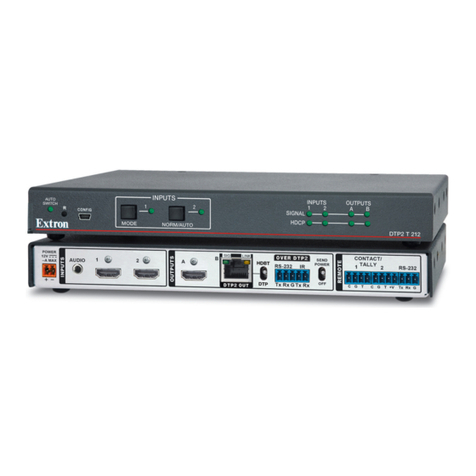
Extron electronics
Extron electronics DTP2 T 212 user guide

Sony
Sony DFS-700 Specifications
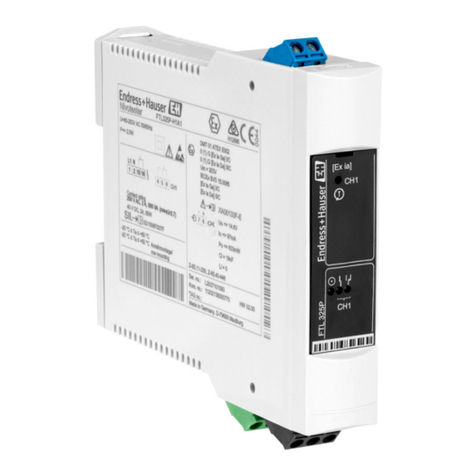
Endress+Hauser
Endress+Hauser nivotester FTL 325 P Brief operating instructions

Weidmüller
Weidmüller IE-SW-EL08-8GTPoE Hardware installation guide
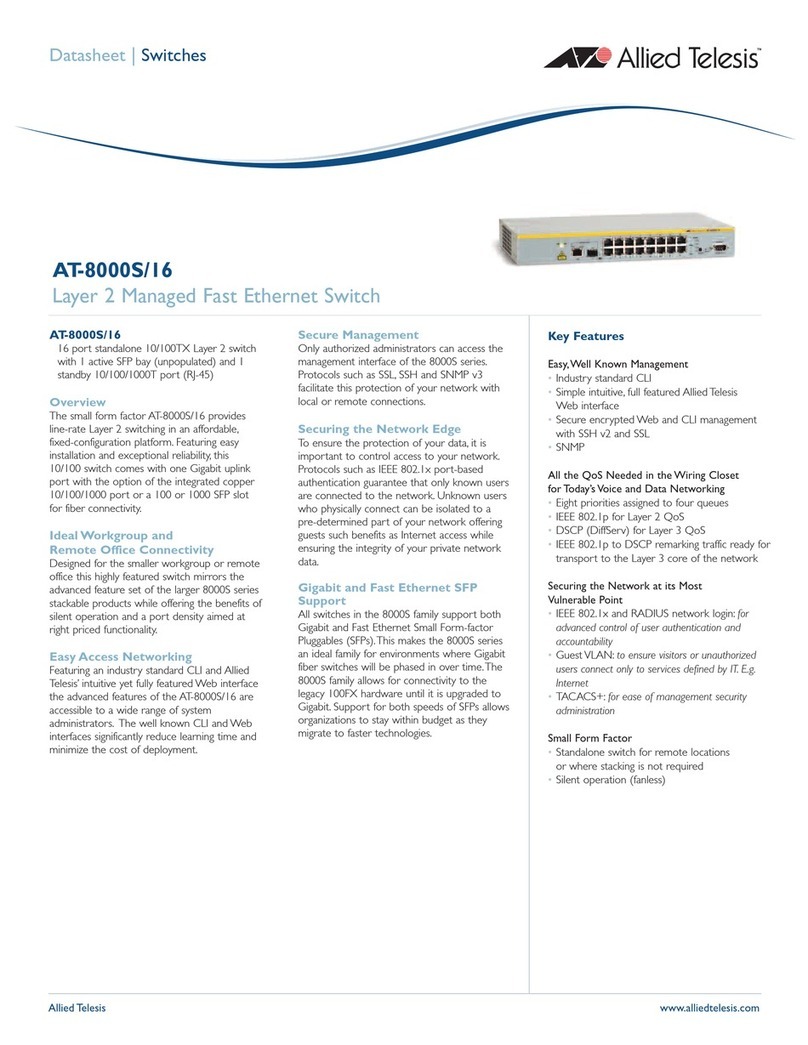
Allied Telesis
Allied Telesis AT-8000S/16 datasheet
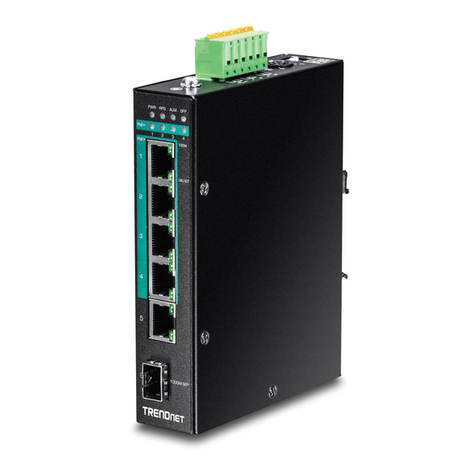
TRENDnet
TRENDnet TI-PG541i Quick installation guide

